LSC UoS BA Business HRM Assignment: J.W. Marriott Report Analysis
VerifiedAdded on 2022/11/29
|13
|3624
|305
Report
AI Summary
This report provides an in-depth analysis of Human Resource Management (HRM) practices at J.W. Marriott, covering various aspects from HR strategies and models to the impact of regional and national culture on HRM. The report examines the value created by firms using HRM strategies, the influence of cultural factors on HRM, and different organizational models of employment. It also explores HRM policies in Asian countries, the importance of local culture in hiring and firing, and the implications of employment laws in international HRM. The report concludes with recommendations based on the findings. This report from Desklib offers a comprehensive overview of HRM principles and their application within a global context.
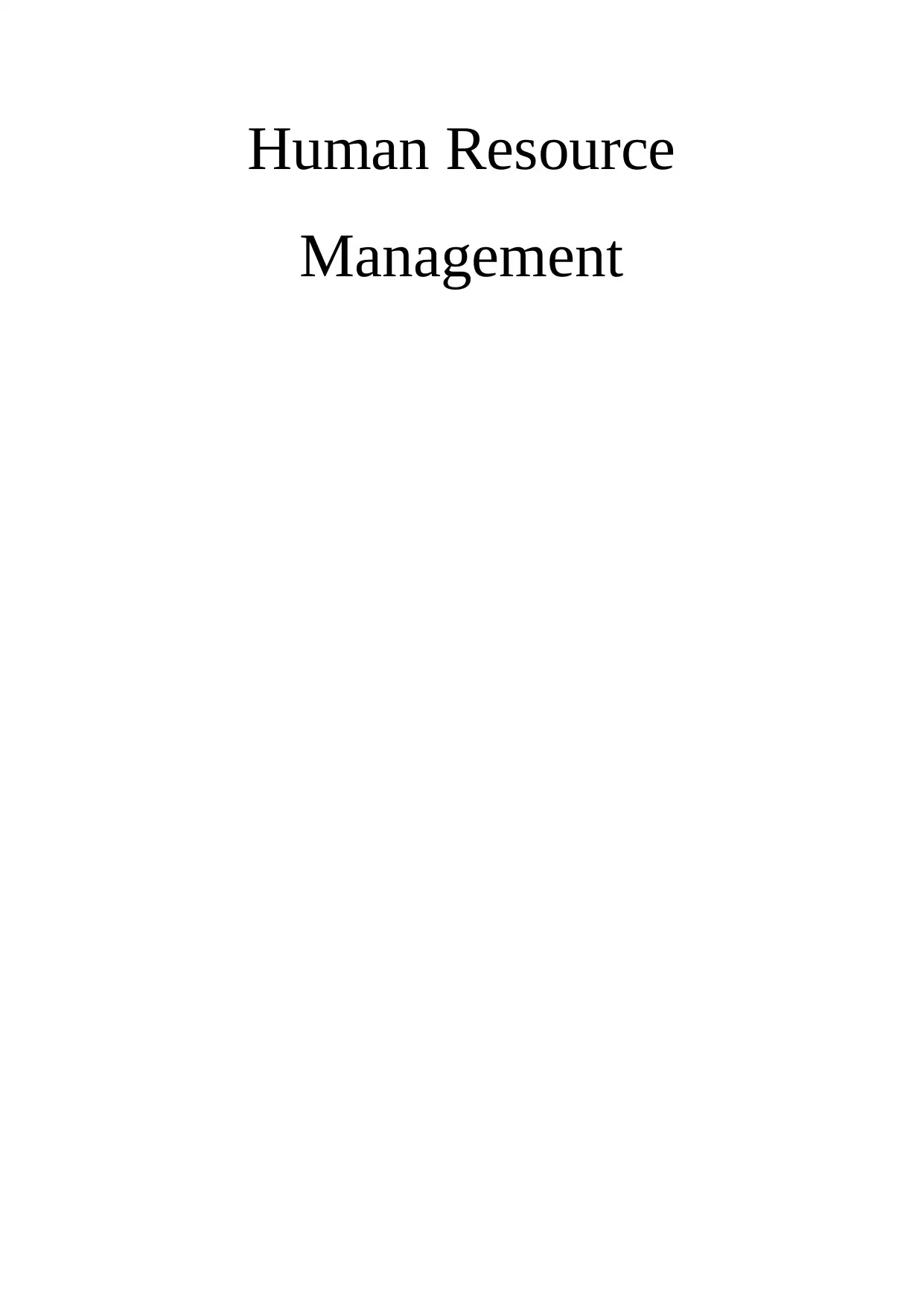
Human Resource
Management
Management
Paraphrase This Document
Need a fresh take? Get an instant paraphrase of this document with our AI Paraphraser
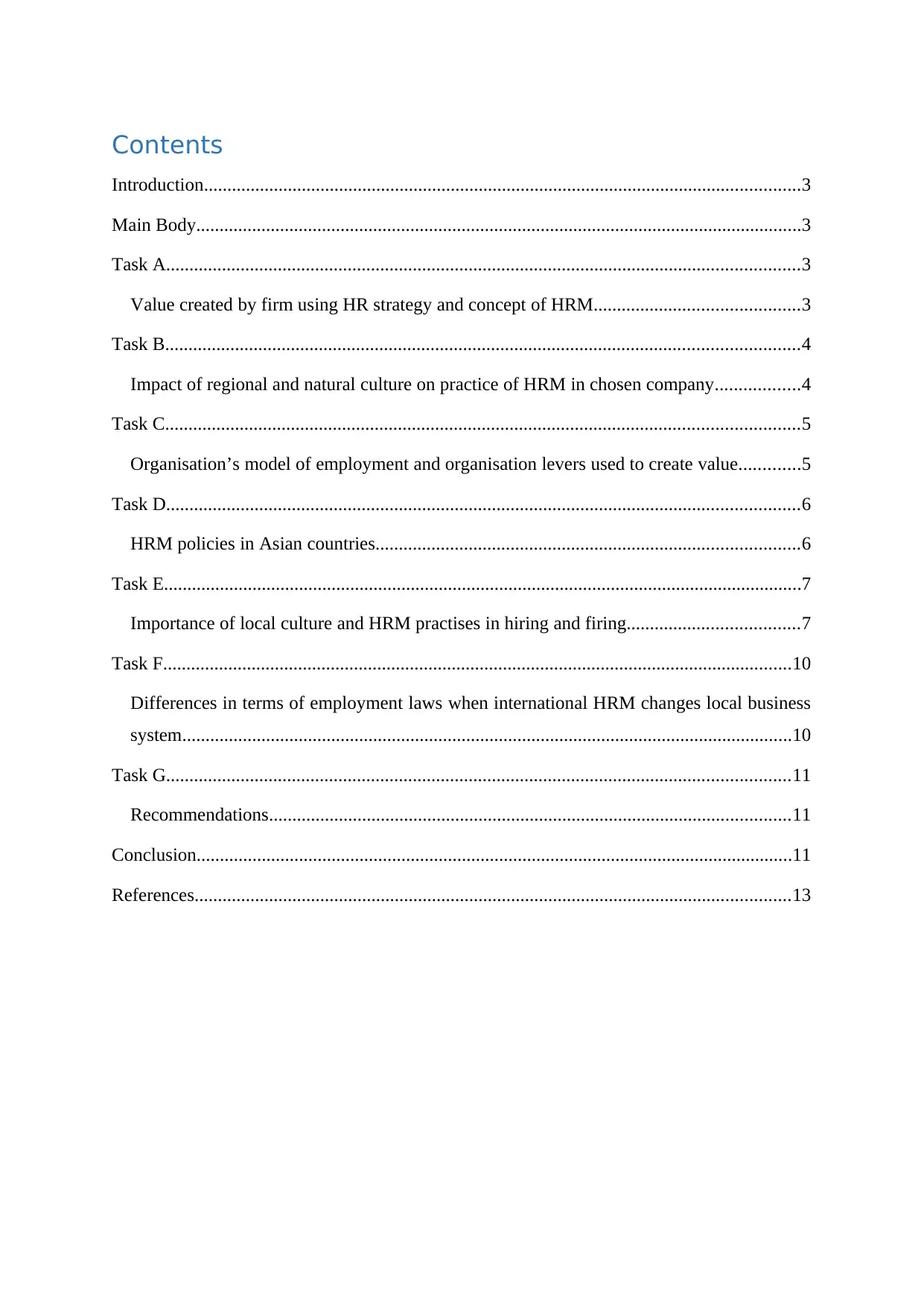
Contents
Introduction................................................................................................................................3
Main Body..................................................................................................................................3
Task A........................................................................................................................................3
Value created by firm using HR strategy and concept of HRM............................................3
Task B........................................................................................................................................4
Impact of regional and natural culture on practice of HRM in chosen company..................4
Task C........................................................................................................................................5
Organisation’s model of employment and organisation levers used to create value.............5
Task D........................................................................................................................................6
HRM policies in Asian countries...........................................................................................6
Task E.........................................................................................................................................7
Importance of local culture and HRM practises in hiring and firing.....................................7
Task F.......................................................................................................................................10
Differences in terms of employment laws when international HRM changes local business
system...................................................................................................................................10
Task G......................................................................................................................................11
Recommendations................................................................................................................11
Conclusion................................................................................................................................11
References................................................................................................................................13
Introduction................................................................................................................................3
Main Body..................................................................................................................................3
Task A........................................................................................................................................3
Value created by firm using HR strategy and concept of HRM............................................3
Task B........................................................................................................................................4
Impact of regional and natural culture on practice of HRM in chosen company..................4
Task C........................................................................................................................................5
Organisation’s model of employment and organisation levers used to create value.............5
Task D........................................................................................................................................6
HRM policies in Asian countries...........................................................................................6
Task E.........................................................................................................................................7
Importance of local culture and HRM practises in hiring and firing.....................................7
Task F.......................................................................................................................................10
Differences in terms of employment laws when international HRM changes local business
system...................................................................................................................................10
Task G......................................................................................................................................11
Recommendations................................................................................................................11
Conclusion................................................................................................................................11
References................................................................................................................................13
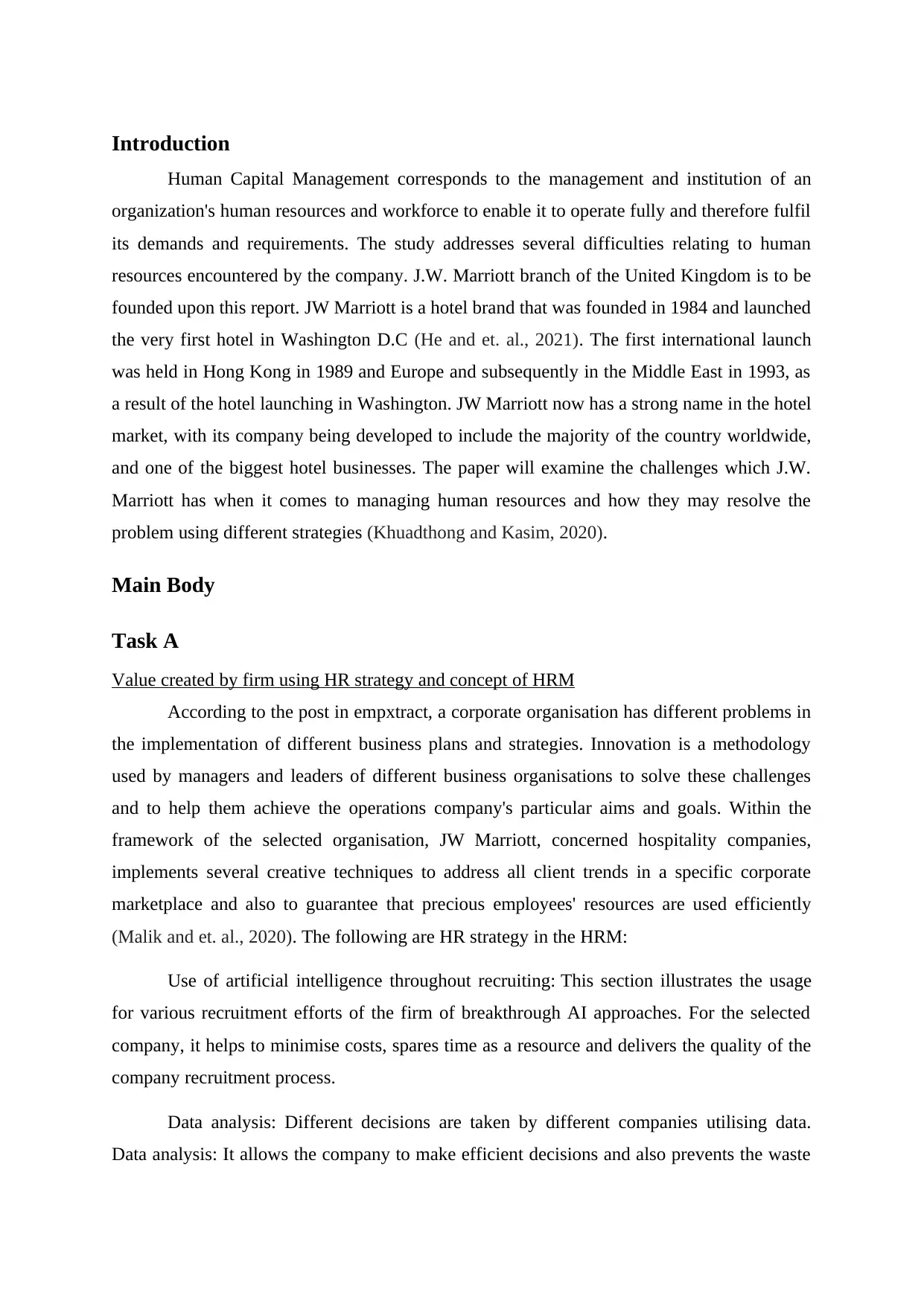
Introduction
Human Capital Management corresponds to the management and institution of an
organization's human resources and workforce to enable it to operate fully and therefore fulfil
its demands and requirements. The study addresses several difficulties relating to human
resources encountered by the company. J.W. Marriott branch of the United Kingdom is to be
founded upon this report. JW Marriott is a hotel brand that was founded in 1984 and launched
the very first hotel in Washington D.C (He and et. al., 2021). The first international launch
was held in Hong Kong in 1989 and Europe and subsequently in the Middle East in 1993, as
a result of the hotel launching in Washington. JW Marriott now has a strong name in the hotel
market, with its company being developed to include the majority of the country worldwide,
and one of the biggest hotel businesses. The paper will examine the challenges which J.W.
Marriott has when it comes to managing human resources and how they may resolve the
problem using different strategies (Khuadthong and Kasim, 2020).
Main Body
Task A
Value created by firm using HR strategy and concept of HRM
According to the post in empxtract, a corporate organisation has different problems in
the implementation of different business plans and strategies. Innovation is a methodology
used by managers and leaders of different business organisations to solve these challenges
and to help them achieve the operations company's particular aims and goals. Within the
framework of the selected organisation, JW Marriott, concerned hospitality companies,
implements several creative techniques to address all client trends in a specific corporate
marketplace and also to guarantee that precious employees' resources are used efficiently
(Malik and et. al., 2020). The following are HR strategy in the HRM:
Use of artificial intelligence throughout recruiting: This section illustrates the usage
for various recruitment efforts of the firm of breakthrough AI approaches. For the selected
company, it helps to minimise costs, spares time as a resource and delivers the quality of the
company recruitment process.
Data analysis: Different decisions are taken by different companies utilising data.
Data analysis: It allows the company to make efficient decisions and also prevents the waste
Human Capital Management corresponds to the management and institution of an
organization's human resources and workforce to enable it to operate fully and therefore fulfil
its demands and requirements. The study addresses several difficulties relating to human
resources encountered by the company. J.W. Marriott branch of the United Kingdom is to be
founded upon this report. JW Marriott is a hotel brand that was founded in 1984 and launched
the very first hotel in Washington D.C (He and et. al., 2021). The first international launch
was held in Hong Kong in 1989 and Europe and subsequently in the Middle East in 1993, as
a result of the hotel launching in Washington. JW Marriott now has a strong name in the hotel
market, with its company being developed to include the majority of the country worldwide,
and one of the biggest hotel businesses. The paper will examine the challenges which J.W.
Marriott has when it comes to managing human resources and how they may resolve the
problem using different strategies (Khuadthong and Kasim, 2020).
Main Body
Task A
Value created by firm using HR strategy and concept of HRM
According to the post in empxtract, a corporate organisation has different problems in
the implementation of different business plans and strategies. Innovation is a methodology
used by managers and leaders of different business organisations to solve these challenges
and to help them achieve the operations company's particular aims and goals. Within the
framework of the selected organisation, JW Marriott, concerned hospitality companies,
implements several creative techniques to address all client trends in a specific corporate
marketplace and also to guarantee that precious employees' resources are used efficiently
(Malik and et. al., 2020). The following are HR strategy in the HRM:
Use of artificial intelligence throughout recruiting: This section illustrates the usage
for various recruitment efforts of the firm of breakthrough AI approaches. For the selected
company, it helps to minimise costs, spares time as a resource and delivers the quality of the
company recruitment process.
Data analysis: Different decisions are taken by different companies utilising data.
Data analysis: It allows the company to make efficient decisions and also prevents the waste
⊘ This is a preview!⊘
Do you want full access?
Subscribe today to unlock all pages.

Trusted by 1+ million students worldwide
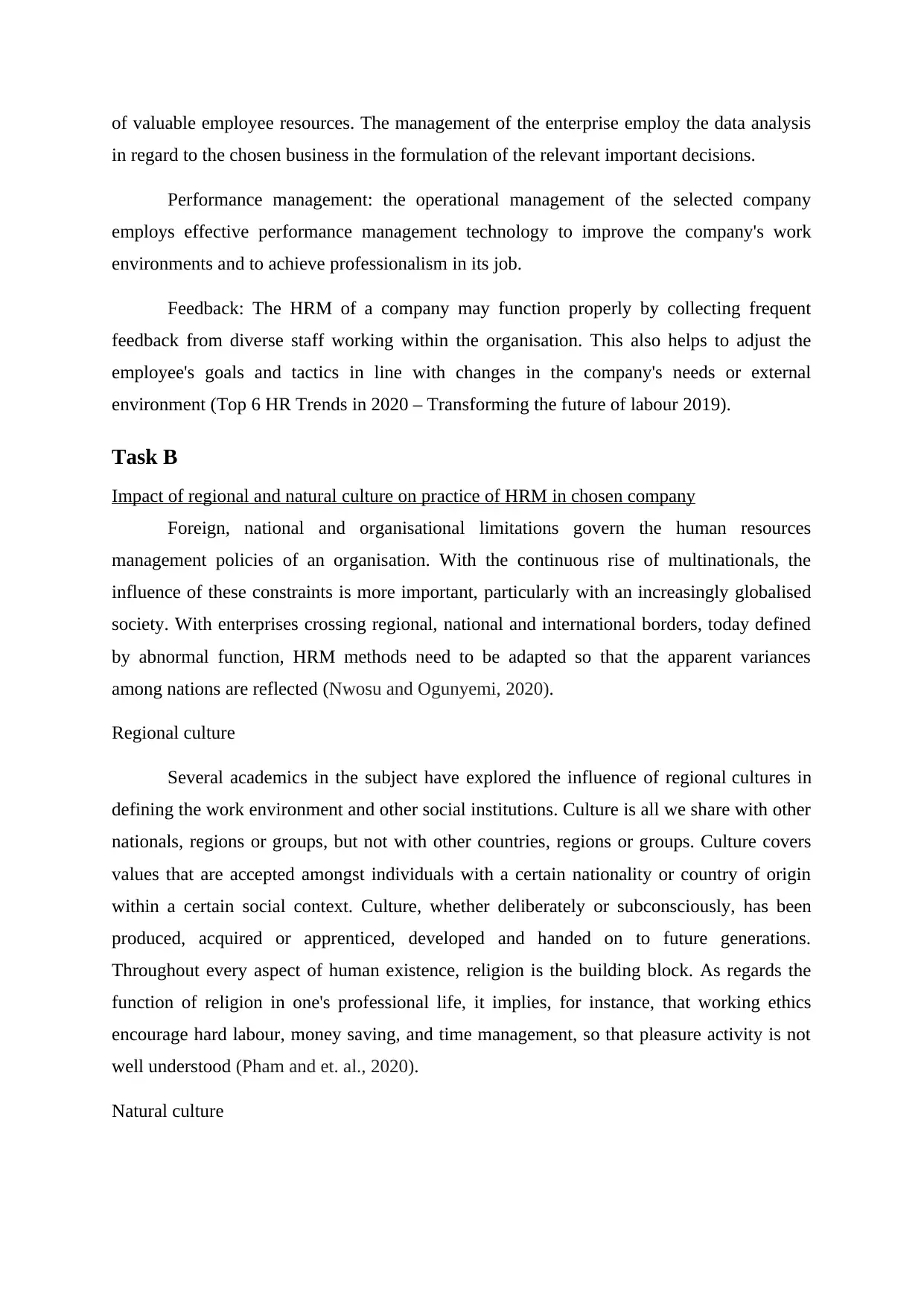
of valuable employee resources. The management of the enterprise employ the data analysis
in regard to the chosen business in the formulation of the relevant important decisions.
Performance management: the operational management of the selected company
employs effective performance management technology to improve the company's work
environments and to achieve professionalism in its job.
Feedback: The HRM of a company may function properly by collecting frequent
feedback from diverse staff working within the organisation. This also helps to adjust the
employee's goals and tactics in line with changes in the company's needs or external
environment (Top 6 HR Trends in 2020 – Transforming the future of labour 2019).
Task B
Impact of regional and natural culture on practice of HRM in chosen company
Foreign, national and organisational limitations govern the human resources
management policies of an organisation. With the continuous rise of multinationals, the
influence of these constraints is more important, particularly with an increasingly globalised
society. With enterprises crossing regional, national and international borders, today defined
by abnormal function, HRM methods need to be adapted so that the apparent variances
among nations are reflected (Nwosu and Ogunyemi, 2020).
Regional culture
Several academics in the subject have explored the influence of regional cultures in
defining the work environment and other social institutions. Culture is all we share with other
nationals, regions or groups, but not with other countries, regions or groups. Culture covers
values that are accepted amongst individuals with a certain nationality or country of origin
within a certain social context. Culture, whether deliberately or subconsciously, has been
produced, acquired or apprenticed, developed and handed on to future generations.
Throughout every aspect of human existence, religion is the building block. As regards the
function of religion in one's professional life, it implies, for instance, that working ethics
encourage hard labour, money saving, and time management, so that pleasure activity is not
well understood (Pham and et. al., 2020).
Natural culture
in regard to the chosen business in the formulation of the relevant important decisions.
Performance management: the operational management of the selected company
employs effective performance management technology to improve the company's work
environments and to achieve professionalism in its job.
Feedback: The HRM of a company may function properly by collecting frequent
feedback from diverse staff working within the organisation. This also helps to adjust the
employee's goals and tactics in line with changes in the company's needs or external
environment (Top 6 HR Trends in 2020 – Transforming the future of labour 2019).
Task B
Impact of regional and natural culture on practice of HRM in chosen company
Foreign, national and organisational limitations govern the human resources
management policies of an organisation. With the continuous rise of multinationals, the
influence of these constraints is more important, particularly with an increasingly globalised
society. With enterprises crossing regional, national and international borders, today defined
by abnormal function, HRM methods need to be adapted so that the apparent variances
among nations are reflected (Nwosu and Ogunyemi, 2020).
Regional culture
Several academics in the subject have explored the influence of regional cultures in
defining the work environment and other social institutions. Culture is all we share with other
nationals, regions or groups, but not with other countries, regions or groups. Culture covers
values that are accepted amongst individuals with a certain nationality or country of origin
within a certain social context. Culture, whether deliberately or subconsciously, has been
produced, acquired or apprenticed, developed and handed on to future generations.
Throughout every aspect of human existence, religion is the building block. As regards the
function of religion in one's professional life, it implies, for instance, that working ethics
encourage hard labour, money saving, and time management, so that pleasure activity is not
well understood (Pham and et. al., 2020).
Natural culture
Paraphrase This Document
Need a fresh take? Get an instant paraphrase of this document with our AI Paraphraser
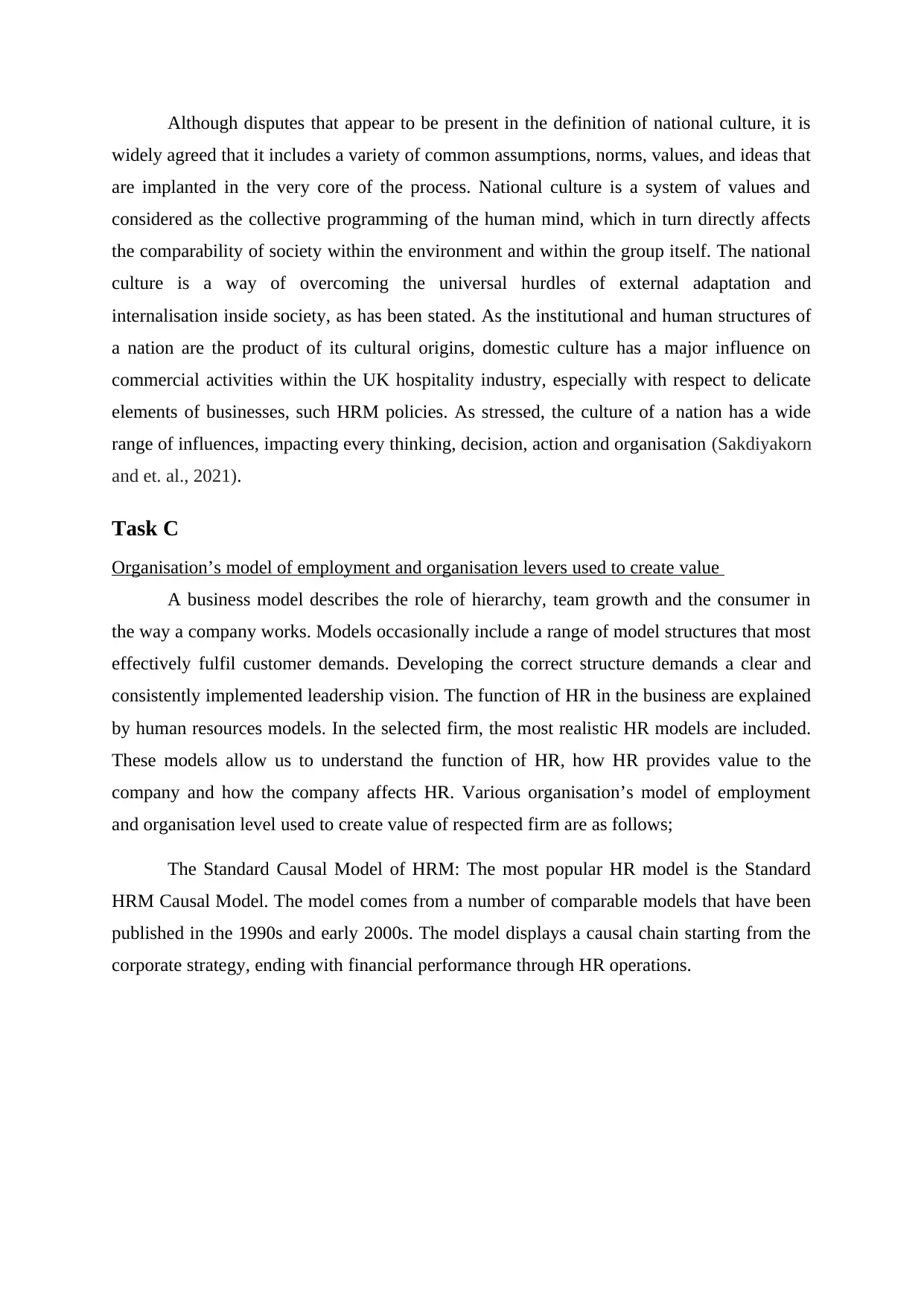
Although disputes that appear to be present in the definition of national culture, it is
widely agreed that it includes a variety of common assumptions, norms, values, and ideas that
are implanted in the very core of the process. National culture is a system of values and
considered as the collective programming of the human mind, which in turn directly affects
the comparability of society within the environment and within the group itself. The national
culture is a way of overcoming the universal hurdles of external adaptation and
internalisation inside society, as has been stated. As the institutional and human structures of
a nation are the product of its cultural origins, domestic culture has a major influence on
commercial activities within the UK hospitality industry, especially with respect to delicate
elements of businesses, such HRM policies. As stressed, the culture of a nation has a wide
range of influences, impacting every thinking, decision, action and organisation (Sakdiyakorn
and et. al., 2021).
Task C
Organisation’s model of employment and organisation levers used to create value
A business model describes the role of hierarchy, team growth and the consumer in
the way a company works. Models occasionally include a range of model structures that most
effectively fulfil customer demands. Developing the correct structure demands a clear and
consistently implemented leadership vision. The function of HR in the business are explained
by human resources models. In the selected firm, the most realistic HR models are included.
These models allow us to understand the function of HR, how HR provides value to the
company and how the company affects HR. Various organisation’s model of employment
and organisation level used to create value of respected firm are as follows;
The Standard Causal Model of HRM: The most popular HR model is the Standard
HRM Causal Model. The model comes from a number of comparable models that have been
published in the 1990s and early 2000s. The model displays a causal chain starting from the
corporate strategy, ending with financial performance through HR operations.
widely agreed that it includes a variety of common assumptions, norms, values, and ideas that
are implanted in the very core of the process. National culture is a system of values and
considered as the collective programming of the human mind, which in turn directly affects
the comparability of society within the environment and within the group itself. The national
culture is a way of overcoming the universal hurdles of external adaptation and
internalisation inside society, as has been stated. As the institutional and human structures of
a nation are the product of its cultural origins, domestic culture has a major influence on
commercial activities within the UK hospitality industry, especially with respect to delicate
elements of businesses, such HRM policies. As stressed, the culture of a nation has a wide
range of influences, impacting every thinking, decision, action and organisation (Sakdiyakorn
and et. al., 2021).
Task C
Organisation’s model of employment and organisation levers used to create value
A business model describes the role of hierarchy, team growth and the consumer in
the way a company works. Models occasionally include a range of model structures that most
effectively fulfil customer demands. Developing the correct structure demands a clear and
consistently implemented leadership vision. The function of HR in the business are explained
by human resources models. In the selected firm, the most realistic HR models are included.
These models allow us to understand the function of HR, how HR provides value to the
company and how the company affects HR. Various organisation’s model of employment
and organisation level used to create value of respected firm are as follows;
The Standard Causal Model of HRM: The most popular HR model is the Standard
HRM Causal Model. The model comes from a number of comparable models that have been
published in the 1990s and early 2000s. The model displays a causal chain starting from the
corporate strategy, ending with financial performance through HR operations.
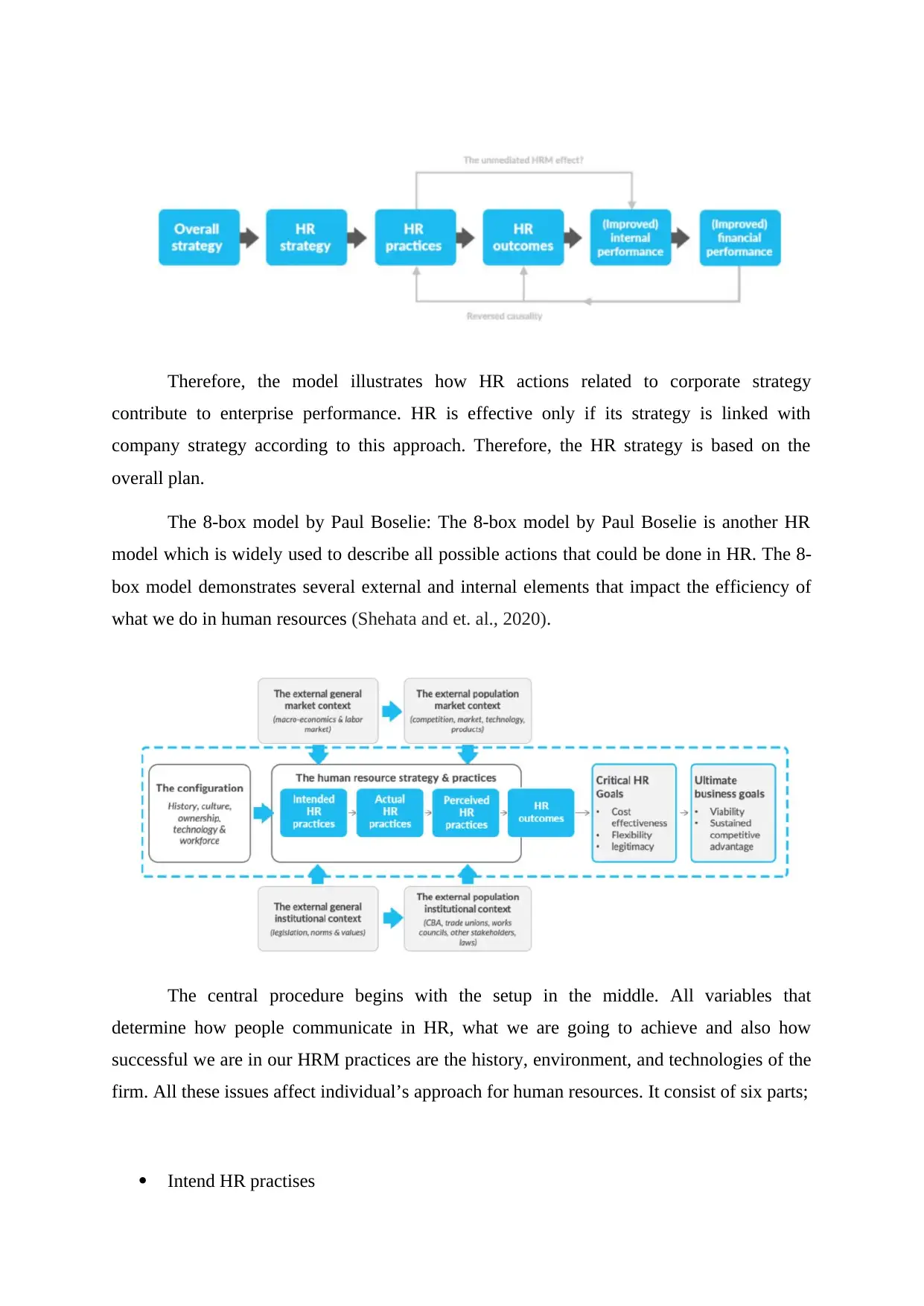
Therefore, the model illustrates how HR actions related to corporate strategy
contribute to enterprise performance. HR is effective only if its strategy is linked with
company strategy according to this approach. Therefore, the HR strategy is based on the
overall plan.
The 8-box model by Paul Boselie: The 8-box model by Paul Boselie is another HR
model which is widely used to describe all possible actions that could be done in HR. The 8-
box model demonstrates several external and internal elements that impact the efficiency of
what we do in human resources (Shehata and et. al., 2020).
The central procedure begins with the setup in the middle. All variables that
determine how people communicate in HR, what we are going to achieve and also how
successful we are in our HRM practices are the history, environment, and technologies of the
firm. All these issues affect individual’s approach for human resources. It consist of six parts;
Intend HR practises
contribute to enterprise performance. HR is effective only if its strategy is linked with
company strategy according to this approach. Therefore, the HR strategy is based on the
overall plan.
The 8-box model by Paul Boselie: The 8-box model by Paul Boselie is another HR
model which is widely used to describe all possible actions that could be done in HR. The 8-
box model demonstrates several external and internal elements that impact the efficiency of
what we do in human resources (Shehata and et. al., 2020).
The central procedure begins with the setup in the middle. All variables that
determine how people communicate in HR, what we are going to achieve and also how
successful we are in our HRM practices are the history, environment, and technologies of the
firm. All these issues affect individual’s approach for human resources. It consist of six parts;
Intend HR practises
⊘ This is a preview!⊘
Do you want full access?
Subscribe today to unlock all pages.

Trusted by 1+ million students worldwide
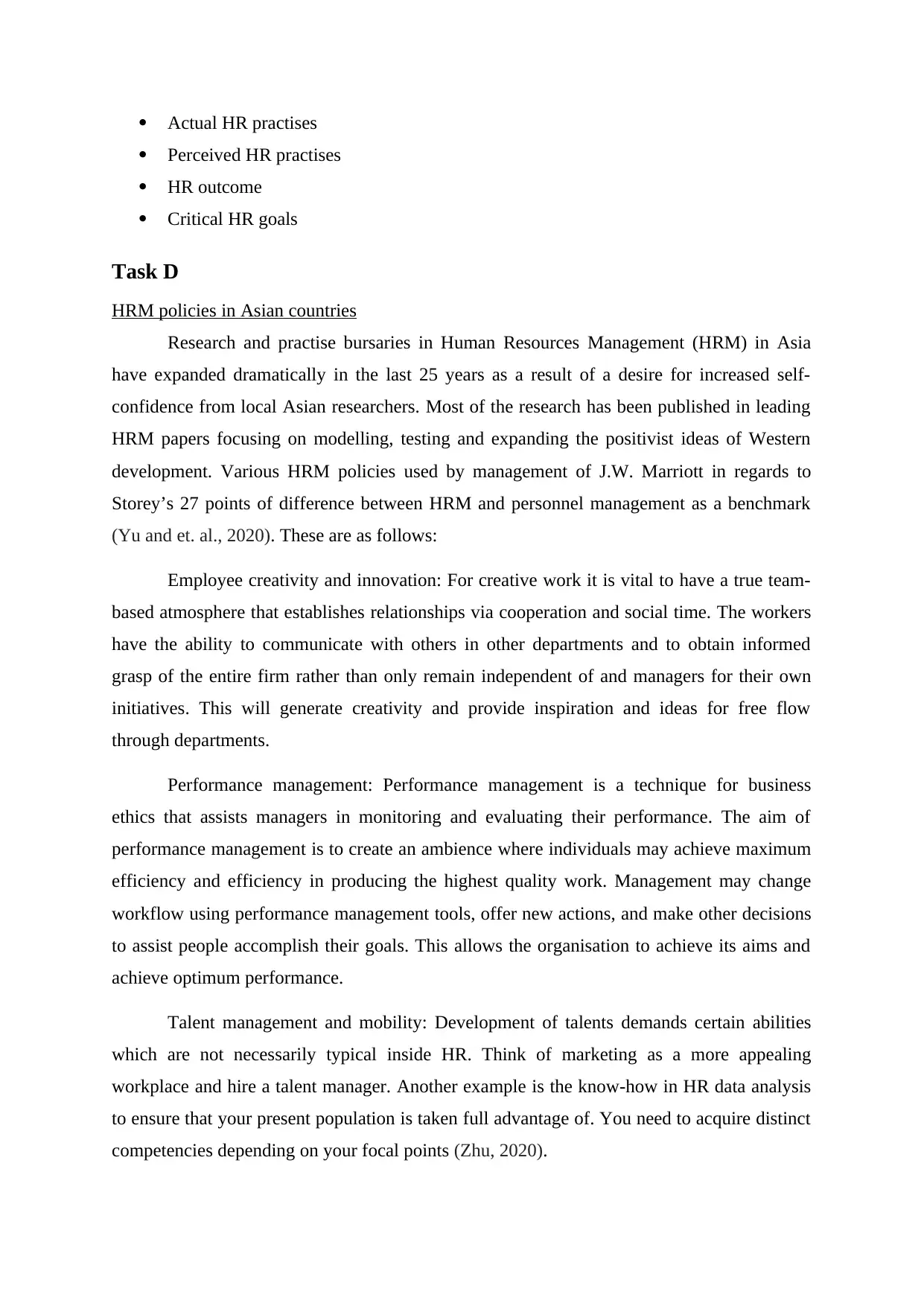
Actual HR practises
Perceived HR practises
HR outcome
Critical HR goals
Task D
HRM policies in Asian countries
Research and practise bursaries in Human Resources Management (HRM) in Asia
have expanded dramatically in the last 25 years as a result of a desire for increased self-
confidence from local Asian researchers. Most of the research has been published in leading
HRM papers focusing on modelling, testing and expanding the positivist ideas of Western
development. Various HRM policies used by management of J.W. Marriott in regards to
Storey’s 27 points of difference between HRM and personnel management as a benchmark
(Yu and et. al., 2020). These are as follows:
Employee creativity and innovation: For creative work it is vital to have a true team-
based atmosphere that establishes relationships via cooperation and social time. The workers
have the ability to communicate with others in other departments and to obtain informed
grasp of the entire firm rather than only remain independent of and managers for their own
initiatives. This will generate creativity and provide inspiration and ideas for free flow
through departments.
Performance management: Performance management is a technique for business
ethics that assists managers in monitoring and evaluating their performance. The aim of
performance management is to create an ambience where individuals may achieve maximum
efficiency and efficiency in producing the highest quality work. Management may change
workflow using performance management tools, offer new actions, and make other decisions
to assist people accomplish their goals. This allows the organisation to achieve its aims and
achieve optimum performance.
Talent management and mobility: Development of talents demands certain abilities
which are not necessarily typical inside HR. Think of marketing as a more appealing
workplace and hire a talent manager. Another example is the know-how in HR data analysis
to ensure that your present population is taken full advantage of. You need to acquire distinct
competencies depending on your focal points (Zhu, 2020).
Perceived HR practises
HR outcome
Critical HR goals
Task D
HRM policies in Asian countries
Research and practise bursaries in Human Resources Management (HRM) in Asia
have expanded dramatically in the last 25 years as a result of a desire for increased self-
confidence from local Asian researchers. Most of the research has been published in leading
HRM papers focusing on modelling, testing and expanding the positivist ideas of Western
development. Various HRM policies used by management of J.W. Marriott in regards to
Storey’s 27 points of difference between HRM and personnel management as a benchmark
(Yu and et. al., 2020). These are as follows:
Employee creativity and innovation: For creative work it is vital to have a true team-
based atmosphere that establishes relationships via cooperation and social time. The workers
have the ability to communicate with others in other departments and to obtain informed
grasp of the entire firm rather than only remain independent of and managers for their own
initiatives. This will generate creativity and provide inspiration and ideas for free flow
through departments.
Performance management: Performance management is a technique for business
ethics that assists managers in monitoring and evaluating their performance. The aim of
performance management is to create an ambience where individuals may achieve maximum
efficiency and efficiency in producing the highest quality work. Management may change
workflow using performance management tools, offer new actions, and make other decisions
to assist people accomplish their goals. This allows the organisation to achieve its aims and
achieve optimum performance.
Talent management and mobility: Development of talents demands certain abilities
which are not necessarily typical inside HR. Think of marketing as a more appealing
workplace and hire a talent manager. Another example is the know-how in HR data analysis
to ensure that your present population is taken full advantage of. You need to acquire distinct
competencies depending on your focal points (Zhu, 2020).
Paraphrase This Document
Need a fresh take? Get an instant paraphrase of this document with our AI Paraphraser
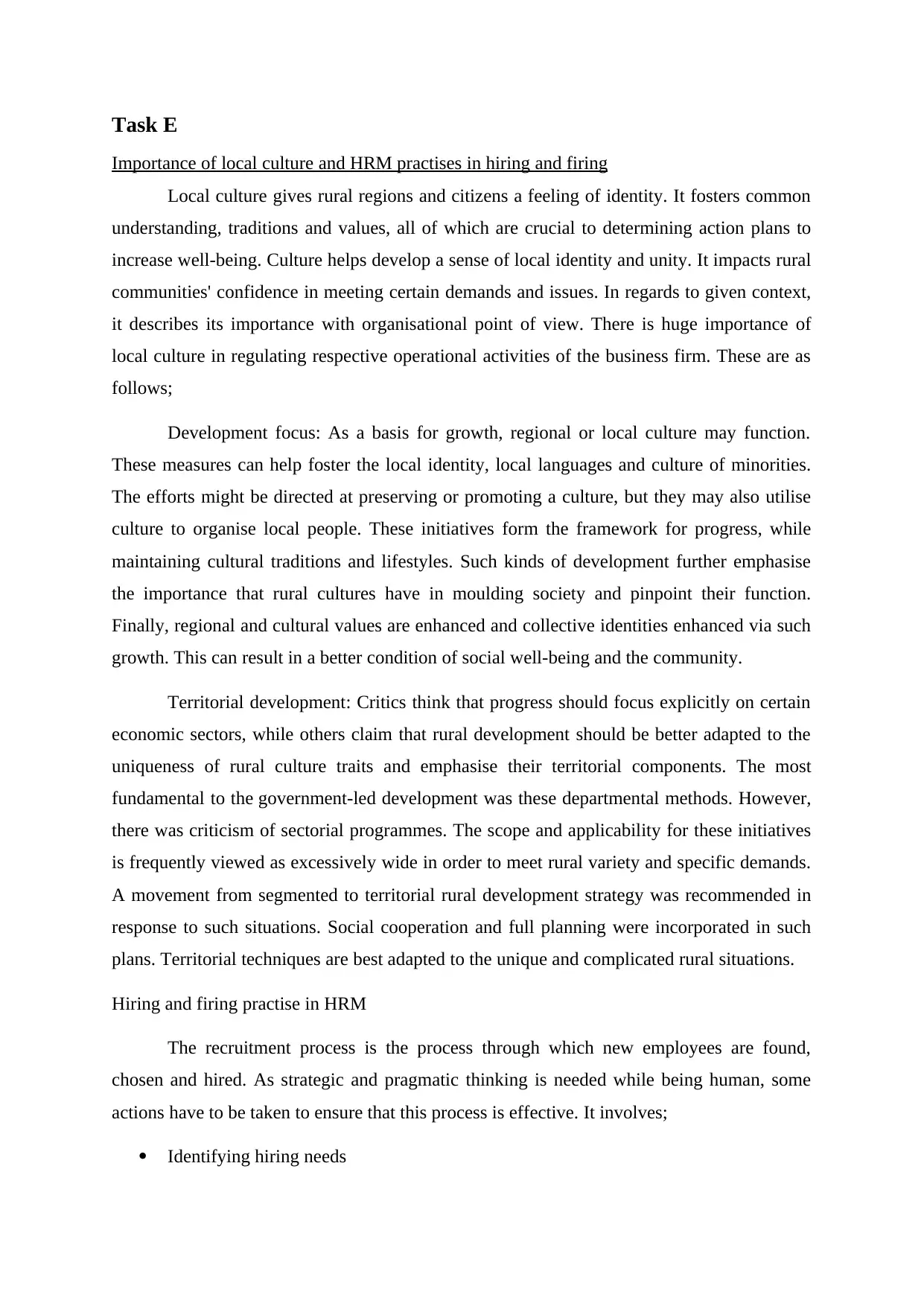
Task E
Importance of local culture and HRM practises in hiring and firing
Local culture gives rural regions and citizens a feeling of identity. It fosters common
understanding, traditions and values, all of which are crucial to determining action plans to
increase well-being. Culture helps develop a sense of local identity and unity. It impacts rural
communities' confidence in meeting certain demands and issues. In regards to given context,
it describes its importance with organisational point of view. There is huge importance of
local culture in regulating respective operational activities of the business firm. These are as
follows;
Development focus: As a basis for growth, regional or local culture may function.
These measures can help foster the local identity, local languages and culture of minorities.
The efforts might be directed at preserving or promoting a culture, but they may also utilise
culture to organise local people. These initiatives form the framework for progress, while
maintaining cultural traditions and lifestyles. Such kinds of development further emphasise
the importance that rural cultures have in moulding society and pinpoint their function.
Finally, regional and cultural values are enhanced and collective identities enhanced via such
growth. This can result in a better condition of social well-being and the community.
Territorial development: Critics think that progress should focus explicitly on certain
economic sectors, while others claim that rural development should be better adapted to the
uniqueness of rural culture traits and emphasise their territorial components. The most
fundamental to the government-led development was these departmental methods. However,
there was criticism of sectorial programmes. The scope and applicability for these initiatives
is frequently viewed as excessively wide in order to meet rural variety and specific demands.
A movement from segmented to territorial rural development strategy was recommended in
response to such situations. Social cooperation and full planning were incorporated in such
plans. Territorial techniques are best adapted to the unique and complicated rural situations.
Hiring and firing practise in HRM
The recruitment process is the process through which new employees are found,
chosen and hired. As strategic and pragmatic thinking is needed while being human, some
actions have to be taken to ensure that this process is effective. It involves;
Identifying hiring needs
Importance of local culture and HRM practises in hiring and firing
Local culture gives rural regions and citizens a feeling of identity. It fosters common
understanding, traditions and values, all of which are crucial to determining action plans to
increase well-being. Culture helps develop a sense of local identity and unity. It impacts rural
communities' confidence in meeting certain demands and issues. In regards to given context,
it describes its importance with organisational point of view. There is huge importance of
local culture in regulating respective operational activities of the business firm. These are as
follows;
Development focus: As a basis for growth, regional or local culture may function.
These measures can help foster the local identity, local languages and culture of minorities.
The efforts might be directed at preserving or promoting a culture, but they may also utilise
culture to organise local people. These initiatives form the framework for progress, while
maintaining cultural traditions and lifestyles. Such kinds of development further emphasise
the importance that rural cultures have in moulding society and pinpoint their function.
Finally, regional and cultural values are enhanced and collective identities enhanced via such
growth. This can result in a better condition of social well-being and the community.
Territorial development: Critics think that progress should focus explicitly on certain
economic sectors, while others claim that rural development should be better adapted to the
uniqueness of rural culture traits and emphasise their territorial components. The most
fundamental to the government-led development was these departmental methods. However,
there was criticism of sectorial programmes. The scope and applicability for these initiatives
is frequently viewed as excessively wide in order to meet rural variety and specific demands.
A movement from segmented to territorial rural development strategy was recommended in
response to such situations. Social cooperation and full planning were incorporated in such
plans. Territorial techniques are best adapted to the unique and complicated rural situations.
Hiring and firing practise in HRM
The recruitment process is the process through which new employees are found,
chosen and hired. As strategic and pragmatic thinking is needed while being human, some
actions have to be taken to ensure that this process is effective. It involves;
Identifying hiring needs
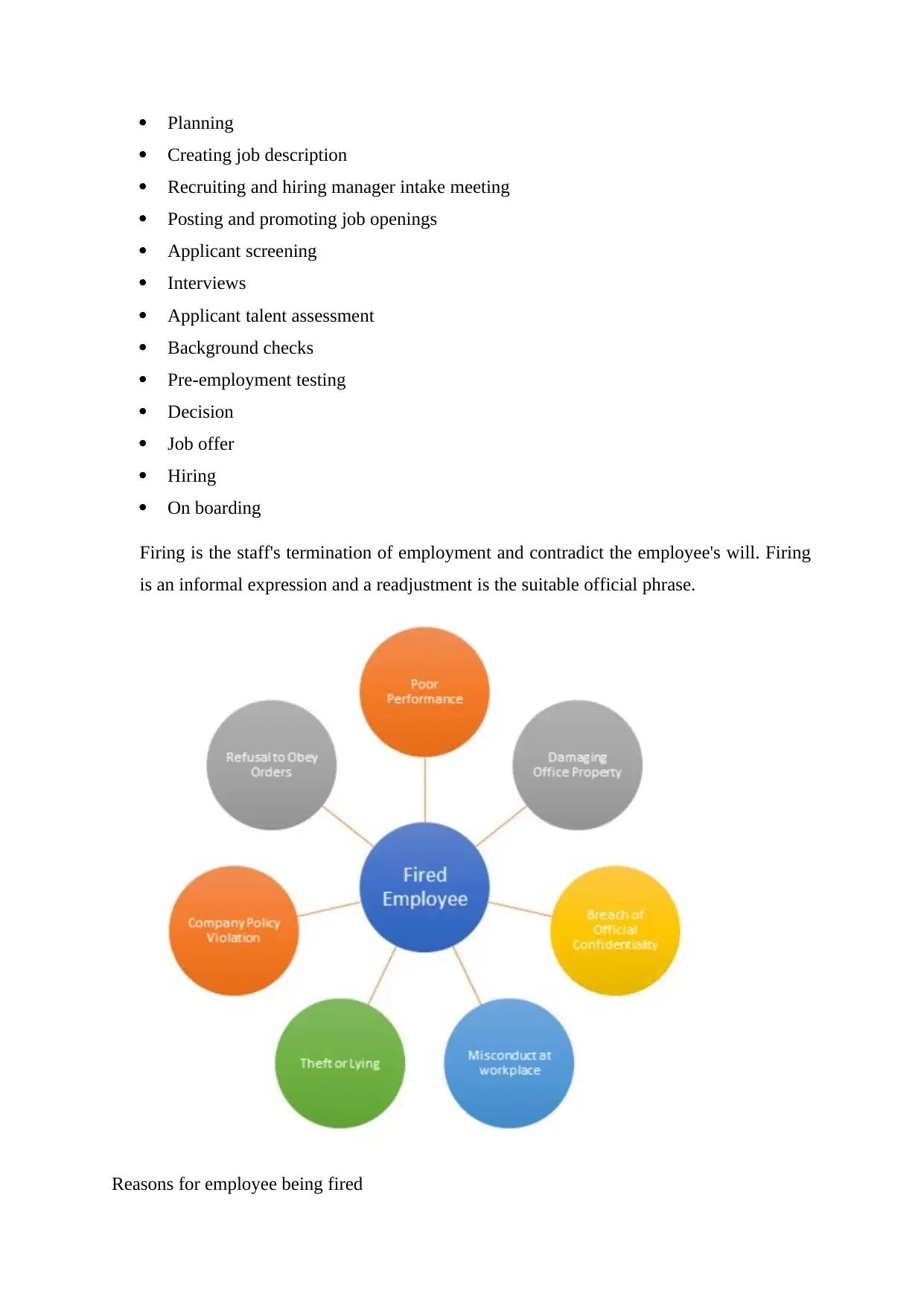
Planning
Creating job description
Recruiting and hiring manager intake meeting
Posting and promoting job openings
Applicant screening
Interviews
Applicant talent assessment
Background checks
Pre-employment testing
Decision
Job offer
Hiring
On boarding
Firing is the staff's termination of employment and contradict the employee's will. Firing
is an informal expression and a readjustment is the suitable official phrase.
Reasons for employee being fired
Creating job description
Recruiting and hiring manager intake meeting
Posting and promoting job openings
Applicant screening
Interviews
Applicant talent assessment
Background checks
Pre-employment testing
Decision
Job offer
Hiring
On boarding
Firing is the staff's termination of employment and contradict the employee's will. Firing
is an informal expression and a readjustment is the suitable official phrase.
Reasons for employee being fired
⊘ This is a preview!⊘
Do you want full access?
Subscribe today to unlock all pages.

Trusted by 1+ million students worldwide
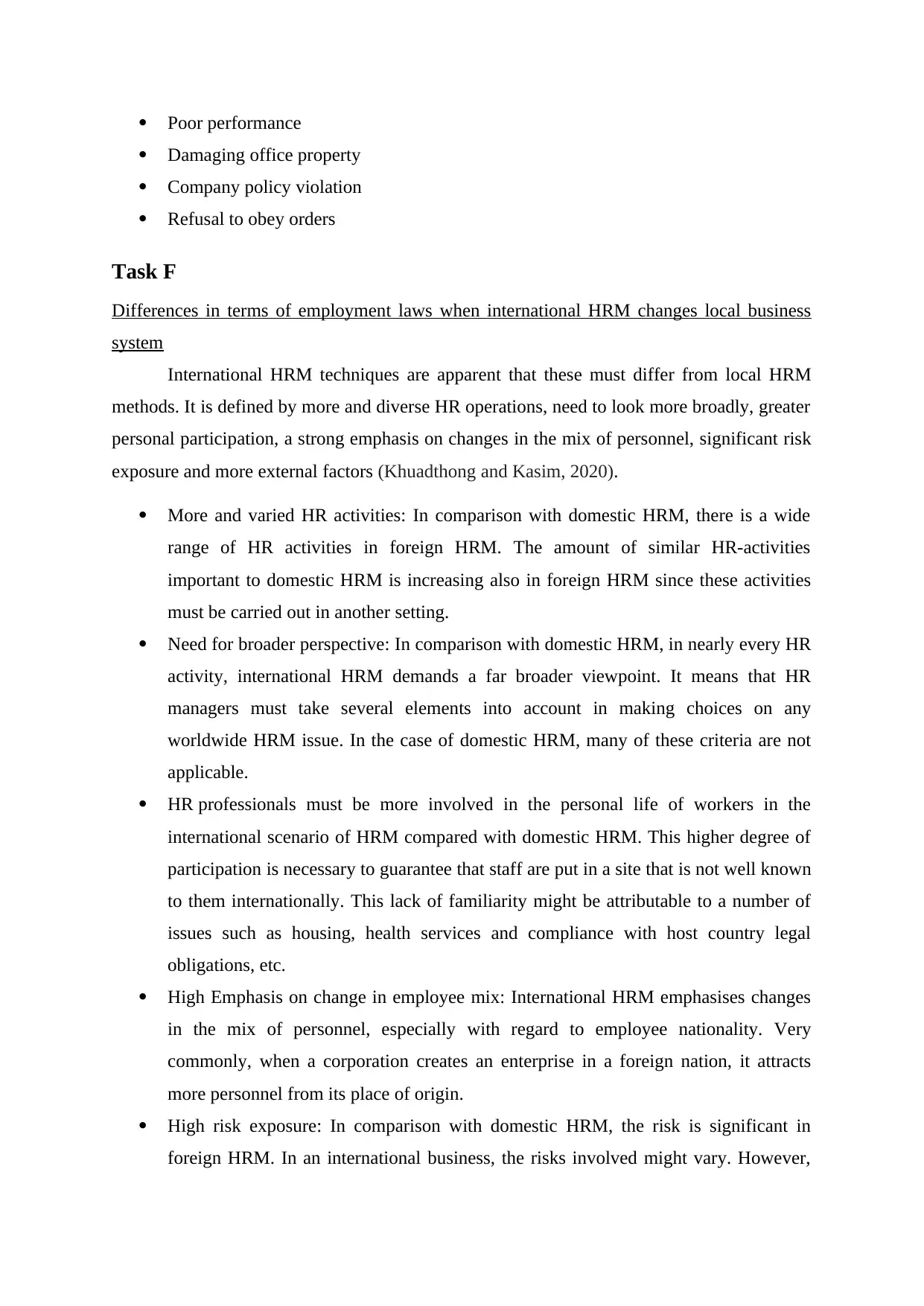
Poor performance
Damaging office property
Company policy violation
Refusal to obey orders
Task F
Differences in terms of employment laws when international HRM changes local business
system
International HRM techniques are apparent that these must differ from local HRM
methods. It is defined by more and diverse HR operations, need to look more broadly, greater
personal participation, a strong emphasis on changes in the mix of personnel, significant risk
exposure and more external factors (Khuadthong and Kasim, 2020).
More and varied HR activities: In comparison with domestic HRM, there is a wide
range of HR activities in foreign HRM. The amount of similar HR-activities
important to domestic HRM is increasing also in foreign HRM since these activities
must be carried out in another setting.
Need for broader perspective: In comparison with domestic HRM, in nearly every HR
activity, international HRM demands a far broader viewpoint. It means that HR
managers must take several elements into account in making choices on any
worldwide HRM issue. In the case of domestic HRM, many of these criteria are not
applicable.
HR professionals must be more involved in the personal life of workers in the
international scenario of HRM compared with domestic HRM. This higher degree of
participation is necessary to guarantee that staff are put in a site that is not well known
to them internationally. This lack of familiarity might be attributable to a number of
issues such as housing, health services and compliance with host country legal
obligations, etc.
High Emphasis on change in employee mix: International HRM emphasises changes
in the mix of personnel, especially with regard to employee nationality. Very
commonly, when a corporation creates an enterprise in a foreign nation, it attracts
more personnel from its place of origin.
High risk exposure: In comparison with domestic HRM, the risk is significant in
foreign HRM. In an international business, the risks involved might vary. However,
Damaging office property
Company policy violation
Refusal to obey orders
Task F
Differences in terms of employment laws when international HRM changes local business
system
International HRM techniques are apparent that these must differ from local HRM
methods. It is defined by more and diverse HR operations, need to look more broadly, greater
personal participation, a strong emphasis on changes in the mix of personnel, significant risk
exposure and more external factors (Khuadthong and Kasim, 2020).
More and varied HR activities: In comparison with domestic HRM, there is a wide
range of HR activities in foreign HRM. The amount of similar HR-activities
important to domestic HRM is increasing also in foreign HRM since these activities
must be carried out in another setting.
Need for broader perspective: In comparison with domestic HRM, in nearly every HR
activity, international HRM demands a far broader viewpoint. It means that HR
managers must take several elements into account in making choices on any
worldwide HRM issue. In the case of domestic HRM, many of these criteria are not
applicable.
HR professionals must be more involved in the personal life of workers in the
international scenario of HRM compared with domestic HRM. This higher degree of
participation is necessary to guarantee that staff are put in a site that is not well known
to them internationally. This lack of familiarity might be attributable to a number of
issues such as housing, health services and compliance with host country legal
obligations, etc.
High Emphasis on change in employee mix: International HRM emphasises changes
in the mix of personnel, especially with regard to employee nationality. Very
commonly, when a corporation creates an enterprise in a foreign nation, it attracts
more personnel from its place of origin.
High risk exposure: In comparison with domestic HRM, the risk is significant in
foreign HRM. In an international business, the risks involved might vary. However,
Paraphrase This Document
Need a fresh take? Get an instant paraphrase of this document with our AI Paraphraser
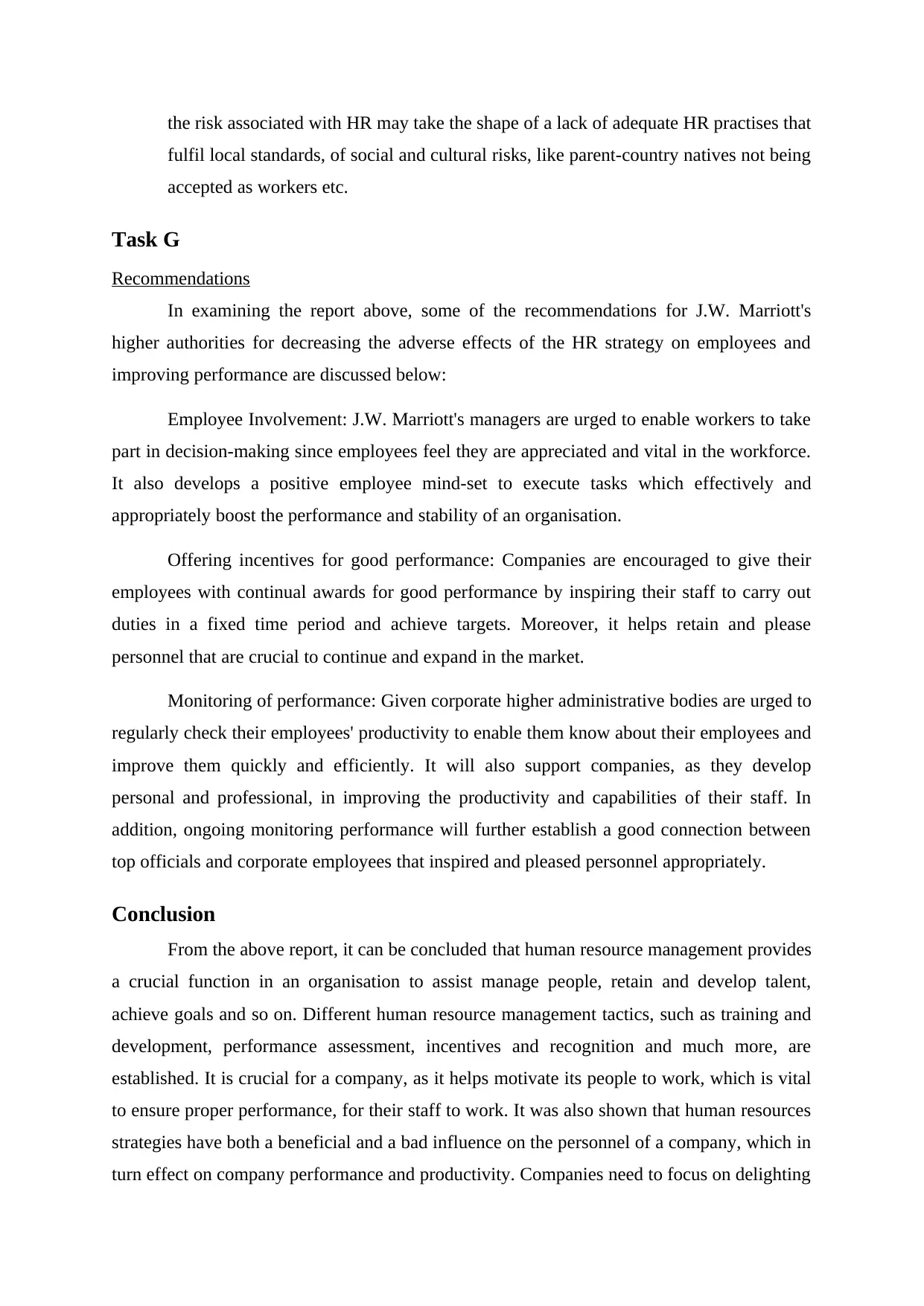
the risk associated with HR may take the shape of a lack of adequate HR practises that
fulfil local standards, of social and cultural risks, like parent-country natives not being
accepted as workers etc.
Task G
Recommendations
In examining the report above, some of the recommendations for J.W. Marriott's
higher authorities for decreasing the adverse effects of the HR strategy on employees and
improving performance are discussed below:
Employee Involvement: J.W. Marriott's managers are urged to enable workers to take
part in decision-making since employees feel they are appreciated and vital in the workforce.
It also develops a positive employee mind-set to execute tasks which effectively and
appropriately boost the performance and stability of an organisation.
Offering incentives for good performance: Companies are encouraged to give their
employees with continual awards for good performance by inspiring their staff to carry out
duties in a fixed time period and achieve targets. Moreover, it helps retain and please
personnel that are crucial to continue and expand in the market.
Monitoring of performance: Given corporate higher administrative bodies are urged to
regularly check their employees' productivity to enable them know about their employees and
improve them quickly and efficiently. It will also support companies, as they develop
personal and professional, in improving the productivity and capabilities of their staff. In
addition, ongoing monitoring performance will further establish a good connection between
top officials and corporate employees that inspired and pleased personnel appropriately.
Conclusion
From the above report, it can be concluded that human resource management provides
a crucial function in an organisation to assist manage people, retain and develop talent,
achieve goals and so on. Different human resource management tactics, such as training and
development, performance assessment, incentives and recognition and much more, are
established. It is crucial for a company, as it helps motivate its people to work, which is vital
to ensure proper performance, for their staff to work. It was also shown that human resources
strategies have both a beneficial and a bad influence on the personnel of a company, which in
turn effect on company performance and productivity. Companies need to focus on delighting
fulfil local standards, of social and cultural risks, like parent-country natives not being
accepted as workers etc.
Task G
Recommendations
In examining the report above, some of the recommendations for J.W. Marriott's
higher authorities for decreasing the adverse effects of the HR strategy on employees and
improving performance are discussed below:
Employee Involvement: J.W. Marriott's managers are urged to enable workers to take
part in decision-making since employees feel they are appreciated and vital in the workforce.
It also develops a positive employee mind-set to execute tasks which effectively and
appropriately boost the performance and stability of an organisation.
Offering incentives for good performance: Companies are encouraged to give their
employees with continual awards for good performance by inspiring their staff to carry out
duties in a fixed time period and achieve targets. Moreover, it helps retain and please
personnel that are crucial to continue and expand in the market.
Monitoring of performance: Given corporate higher administrative bodies are urged to
regularly check their employees' productivity to enable them know about their employees and
improve them quickly and efficiently. It will also support companies, as they develop
personal and professional, in improving the productivity and capabilities of their staff. In
addition, ongoing monitoring performance will further establish a good connection between
top officials and corporate employees that inspired and pleased personnel appropriately.
Conclusion
From the above report, it can be concluded that human resource management provides
a crucial function in an organisation to assist manage people, retain and develop talent,
achieve goals and so on. Different human resource management tactics, such as training and
development, performance assessment, incentives and recognition and much more, are
established. It is crucial for a company, as it helps motivate its people to work, which is vital
to ensure proper performance, for their staff to work. It was also shown that human resources
strategies have both a beneficial and a bad influence on the personnel of a company, which in
turn effect on company performance and productivity. Companies need to focus on delighting
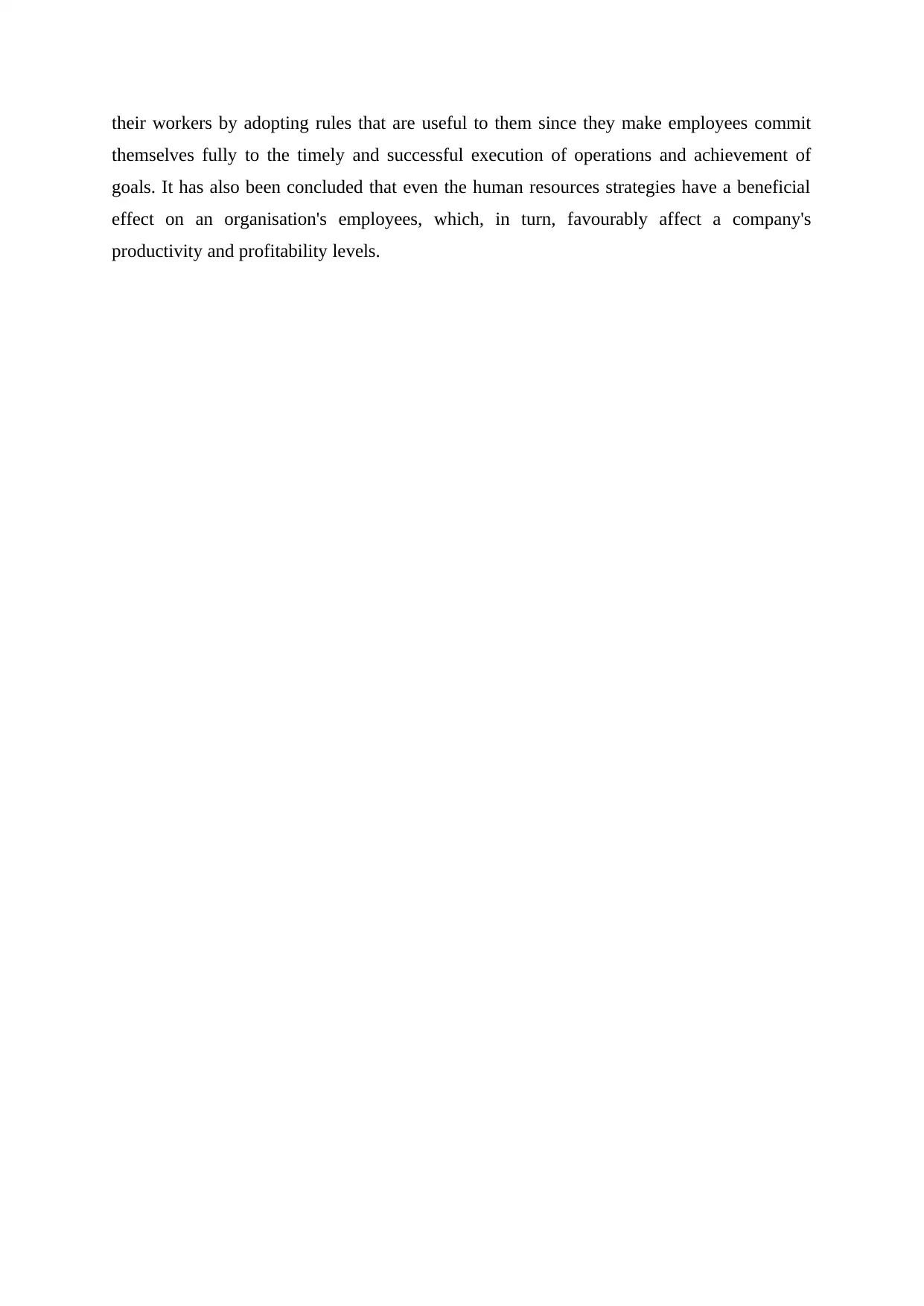
their workers by adopting rules that are useful to them since they make employees commit
themselves fully to the timely and successful execution of operations and achievement of
goals. It has also been concluded that even the human resources strategies have a beneficial
effect on an organisation's employees, which, in turn, favourably affect a company's
productivity and profitability levels.
themselves fully to the timely and successful execution of operations and achievement of
goals. It has also been concluded that even the human resources strategies have a beneficial
effect on an organisation's employees, which, in turn, favourably affect a company's
productivity and profitability levels.
⊘ This is a preview!⊘
Do you want full access?
Subscribe today to unlock all pages.

Trusted by 1+ million students worldwide
1 out of 13
Related Documents
Your All-in-One AI-Powered Toolkit for Academic Success.
+13062052269
info@desklib.com
Available 24*7 on WhatsApp / Email
![[object Object]](/_next/static/media/star-bottom.7253800d.svg)
Unlock your academic potential
Copyright © 2020–2025 A2Z Services. All Rights Reserved. Developed and managed by ZUCOL.




